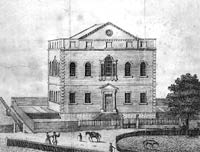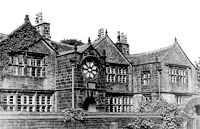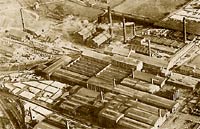Calderdale Architecture

To a great extent the style of architecture in Calderdale has followed the general trend throughout the country. Following on from the primitive huts of the earlier inhabitants there was to be a major change with the palatial villas which came to be built by the wealthier Romans during their four hundred year occupation, which in turn reverted to the roughly built homes of the Saxons. Then came further changes with the Norman influence, and these again were most apparent in the homes and strongholds of the wealthy upper class. The building of castles in the early style of motte and bailey, and the smaller but strongly built manor houses, followed the French pattern and brought new ideas to Britain, but along with this domestic and military activity the building of churches and abbeys went hand in hand, and the simple Saxon churches were superseded by more grandiose architecture raised to the glory of God. The size and style of some of these ecclesiastical buildings meant that they were many years in the building and the men who designed them and commenced building in many cases never lived to see the finished church or cathedral, which made their work an act of pure faith worthy of its product.
Although Yorkshire was no more than a province the varied evidence of changing life-styles throughout these periods was clear to be seen, although to some extent Calderdale was more an area of Roman roads and wayside camps than of villas and full-scale forts, and the Norman occupation too, in this northern district, brought fewer changes than in the south.
For the ordinary person a house was still an erection of timber, in many parts of the country roofed with straw or the more intricately woven thatch, although in Yorkshire the method of covering a roof with stone and later with slate was soon to be adopted. Indeed the thatched roof was a refinement which failed to find widespread favour in the north, unlike many southern parts of the country where this type of housing became popular and is still to be seen in many towns and villages today.

In the Middle Ages stone was a material reserved almost entirely for the building of churches and abbeys and its use in domestic architecture was to come much later. It was common practice in Calderdale, as in many other places, to strengthen old timber buildings and render them more weather-proof by encasing the original timber and plaster structure in an outer covering of stone; it was considerably later that new houses were to be built entirely from this local product at the outset. The stone was quarried locally and in addition to its use in constructing houses and other buildings in this area it was conveyed to other parts of the country and later to other parts of the world.
Perhaps the most characteristic feature of Calderdale architecture is the presence of the 17th and 18th century handloom weavers' cottages with their typical mullioned windows and the existence of a loom chamber on the upper floor. This, above all, demonstrates the dependence of the local population on wool and the textile trade, while at the same time exhibiting its effect on the actual buildings of West Yorkshire.
Three of the most interesting architectural features of Halifax are those pointed out to tourists - the unusual Wainhouse Tower, a structure which was built as an ornamental mill chimney and was modified during construction to become a tower offering spectacular views across the Calder Valley; the Halifax Piece Hall, opened in 1779 for the sale of pieces of cloth and later becoming a wholesale fruit and vegetable market; and Shibden Hall, built in the early fifteenth century by William Otes.

By the Victorian age the industrialisation of the country, particularly in the north, had resulted in the widespread building of long rows of back-to-back houses and cottages for mill and factory workers, some of which, although cramped and inconvenient by modern standards, had interesting features. One of these was the galleried house which was a row of houses of several storeys with one row above another. The upper houses had access to their doors along an iron-railed gallery and in some cases the houses at ground level were cottages of perhaps only two rooms.
Improvements in the lot of the working man came with the paternalistic attitude of wealthy businessmen such as Colonel Edward Akroyd and Sir Francis Crossley and his two brothers John and Joseph who built specially designed houses and artisans' cottages for their workpeople and made them available at reasonable rents or with the option to buy with an early form of mortgage.
This type of housing was common in Calderdale until the period between the two World Wars when Town Councils began their first building schemes, producing estates of modern through houses intended for the working man, and in particular for those people who were being moved from the slums. The advent of World War II put a stop to all building and it was not until two or three years after the cessation of hostilities that the boom of post-war demolition and ambitious housing schemes began, these spreading over much of the rural areas of Calderdale and providing housing away from the town centres. During this time it became common for many people to buy there own homes by a bank mortgage, a decision which was often made due to the difficulty of finding houses available for rent.
The erection of high-rise blocks of flats was a short-lived phenomenon which followed national trends but proved to be a mistake for various reasons and the experiment was curtailed. In the immediate post-war period prefabricated houses were constructed in various areas to house returning servicemen. The advantage of these homes was the speed with which they could be constructed, but they were built with a foreseeable life-span of about ten years. That many of these were still in use long after this period is a tribute to their designers, but also reflected the continuing lack of suitable housing in the district.
Themes
- Calderdale architecture
- Canals in Calderdale
- Chartism
- Colonel Edward Akroyd
- Crossley and Porter School
- Crossley family
- Factory conditions
- Famous people of Calderdale
- The manorial fulling mill
- Growth of education in Calderdale
- Halifax cinemas
- Halifax Moot Hall
- Halifax Theatres
- Hudsonites
- John Fielden
- John Mackintosh
- Military associations with Calderdale
- Musical associations of Calderdale
- Piece Hall
- Plug riots
- Poor law
- Railways in Calderdale
- Role and influence of women in Calderdale
- Social welfare
- Turnpike Roads in Calderdale
- Wainhouse Tower
- World War One
- Yorkshire Coiners


